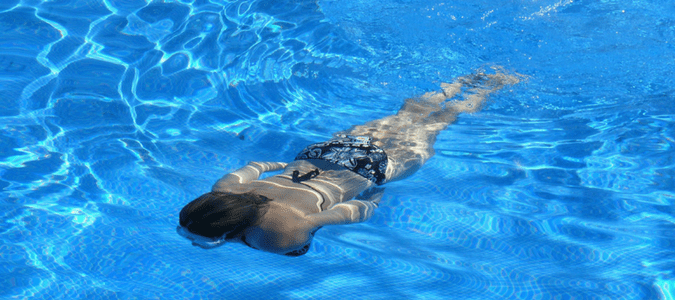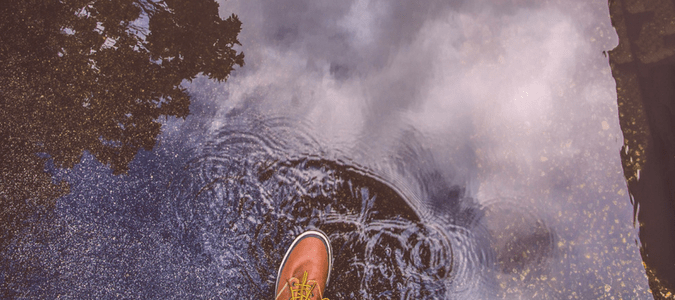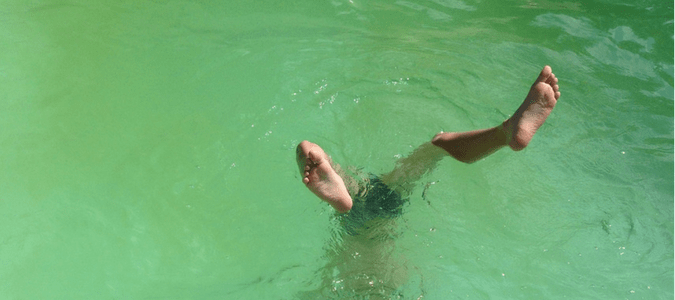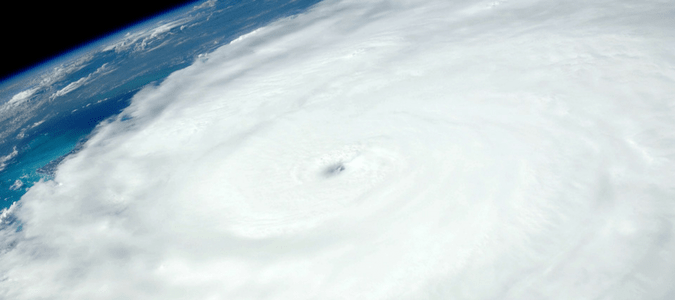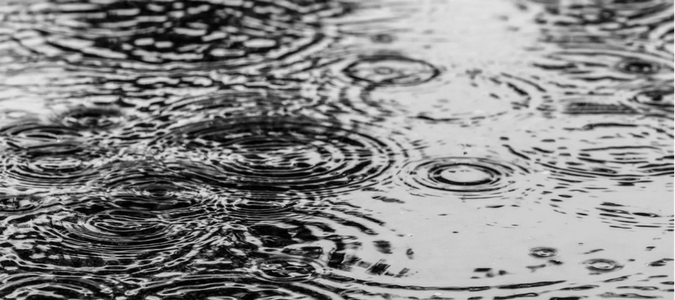
Here in the southern states, we almost always enjoy it when it rains. A good soaking typically cools the temperature and provides our lawn and landscaping with much-needed water. However, there are times when a strong storm, hurricane or tropical depression dumps a lot of rain on our property. That’s when there is too much of a good thing, which can lead to too much water in your pool due to rain.
We’ll tell you what you can do when your area experiences heavy rainfall, how to lower your pool’s water level, what happens when your pool is overflowing from rain, the problems a storm or severe weather event can cause and give you some tips on hurricane pool preparation.
How To Lower Pool Water Level
If you have a typical rainfall, or even several inches, your pool should be fine, since drains and skimmers are designed to remove the excess water. In most cases, your pool can even handle rain from most tropical depressions and hurricanes.
If your pool is full after a storm or heavy rainfall, you don’t need to take drastic steps such as emptying your pool. If you do, the hydrostatic pressure can cause your pool to come out of the ground. However, if you want to lower the water level to help keep your pool from overflowing when heavy rains or a hurricane is coming, you can decrease the water level in your pool by one or two feet. Lowering the water level in your pool is a relatively simple process.
If you have a multiport or dial valve, switch it to the waste position. Don’t forget to turn off the pump beforehand and attach a waste line or backwash hose. Then, turn the pump back on until the water drains by one or two feet. Then, turn the pump back off again. Turn the valve to the filter position, then turn the pump on again.
If you have a push-pull or slide valve, follow the directions above. If you have a DE filter, then recharge the filter with DE.
Cartridge filters don’t have backwash valves, meaning each system differs. If you have a hose bib plumbed into the line, you can drain the water down to the desired level.
Make sure to turn off the skimmer suction line to prevent air from being sucked into it and causing damage to your pump motor.
Pool Overflowing From Rain
Rain, by itself, usually wouldn’t harm your pool. However, as rain falls, it deposits pollen and other particles in the air onto the ground and into your pool. Any runoff into your pool will also contain contaminants, which can quickly turn your relaxing, beautiful oasis into a mess.
As we stated earlier, a typical storm with an average waterfall shouldn’t be a problem since your drains and skimmers should be able to handle the additional water. Pool builders generally plan for coping with being roughly two inches below the level of your home during construction to safeguard against flooding. If your area is inundated with water after more severe storms, as you might experience when a hurricane, tropical storm, or another heavy storm strikes nearby, your area will likely experience flooding. If you get more than five inches of rain in an hour, or if your pool wasn’t designed adequately with sufficient overflows, your pool may overflow, putting you at risk of water getting inside your home and causing severe damage.
As your pool fills with water, it may overflow into your yard. When this rainwater mixes with dirt, mulch, and vegetation, it can upset the chemical balance in your pool. Adding algaecide before a storm can help combat some effects and the pending algae bloom that can follow.
Now that you know how and why your pool might overflow, we’ll continue to discuss what problems too much rain can cause.
Pool Overflowing Problems and How to Prevent Them
Too much water and a pool can be a dangerous combination. If you have water runoff into your pool from surrounding areas under normal conditions, you need to have someone look at your gradient. The deck or grounds and landscaping around your pool should slope away from your pool by ¼ inch for every foot. If you have runoff into your pool after it drizzles, it will be at risk of overflowing after a storm or heavy rainfall.
Having excessive water added to your pool in a relatively short timeframe can lead to several problems, among them malfunctioning of your pool equipment, the accumulation of algae, and deck damage.
Improper Pool Function
Your pool skimmer will help filter out debris and insects that enter your pool, but only if the water level isn’t above the skimmer opening. If the skimmer is covered entirely by water, it won’t work correctly. Robotic skimmers, relatively new to the marketplace, may cause less wear on the pump and pump motor. Some homeowners experience lower utility bills after installing these types of skimmers.
Maintaining your pool before a storm will help alleviate any problems that a storm might cause. For example, if your pool has a crack, heavy rains can compound the problem, similar to what might happen if you have weak spots on your roof.
Algae Blooms
Even if your pool doesn’t overflow, the algae spores from the rain can throw your water chemistry out of balance. When you add the debris from a strong storm, things can get out of hand quickly.
Pool owners should balance the chemistry in their pool before a big storm and directly afterward to bring their pH levels back to their pool to prevent it from turning green or even black.
Pool Deck Damage
If your pool is filled to the brim and water is allowed to sit there for an extended time period, you could experience heaving, lifting, or cracking to your deck if water gets underneath. This problem usually only occurs if you live in an area with clay-based soil and your pool is older. You may see cracks in your concrete deck when this normally dry soil expands when wet, causing an upward force that can elevate the entire deck. Once this has happened, your deck will usually not return to its original level even if just by a small amount.
Cleaning Up After a Storm or Heavy Rain
If your pool has overflowed, you may need to drain some water by following the steps above. Clean the skimmer baskets and use your pool rake to remove the debris floating in the pool. Then, vacuum your swimming pool. You will probably have to run the pump for an extended period to clean debris. If you safely removed the pump before a hurricane, you will need to reinstall it.
After removing the debris from the pool, test the water chemistry and start balancing it. The faster you can start this, the easier to get things back in place. If your pool is looking green after a storm, you can take some simple steps to get it to look crystal clear again.
You’ll also want to check your pressure gauge to see if you need to clean the filter. Running the pump continuously can reduce the time between cleanings. Make sure to check it before and after running the pump.
You can “shock” your pool with chlorine to help get it back in balance and kill any remaining algae.
Hurricane Pool Preparation
From the high winds to the copious amounts of rain, hurricanes and tropical depressions can cause a lot of damage to your pool and other parts of your property. Usually, you do have a warning that a significant weather event is on the way, so you can take the following steps to prepare your pool to protect against damage:
- Disconnect the electrical and gas lines to your pool.
Standing water and electricity don’t mix. Make sure you turn off all power before the storm. Turn off your pool pump and the timer if you have one. Cover the pump and filter if you have a cover. If not, remove it if you can do so safely. Turn off the gas to help prevent any leaks if you have a heated pool or hot tub.
- Prepare the pool water.
Add algaecide to help combat the effects of algae and other rainwater contaminants. Shock the pool by adding chlorine.
- Clear the area.
You don’t want your pool damaged by flying objects. While you can’t completely control this, you can remove all “loose” items, such as lawn furniture, pool equipment and tools, BBQ grills, and more. Those items could damage the walls or bottom of your pool, and the chemicals in the pool can damage those items. Even if those loose items aren’t in your pool, they can become projectiles in high winds. By bringing them inside during the storm or securing them from moving in the case of heavy winds, you decrease the chances of your pool (or even your home) being damaged by these items.
- Trim trees and shrubs.
They are cutting away weak or dying trees, limbs, and shrubs to reduce the damage they can cause to your pool and home.
- Lower your pool’s water level by one to two feet.
Your pool should also have overflow drains that will drain excess water.
- Do not completely drain your pool.
The National Swimming Pool Foundation recommends that pool owners not drain their pools entirely. If you don’t have sufficient water, your pool can be lifted out of the ground. The water helps to “hold down” your pool.
- Remove your pump’s motor.
If you can, remove your pump’s motor, take them inside, and store them in a dry, safe place. If you can’t remove the pump’s motor, tightly wrap it to protect it from a significant storm.
Rain Or Shine, ABC Can Take Care of Your Pool
Having a pool is lovely, but when heavy rain is headed your way, the fear it can overflow can cause significant anxiety. ABC Home & Commercial Services can help you, rain or shine, to handle anything that might come up with your pool. Our swimming pool contractors can help clean your pool after heavy rainfall, take over your regular pool cleaning, and handle all your maintenance and repair needs. With ABC’s extensive pool expertise, you can leave the hard work to us so that you can enjoy your pool worry-free.
